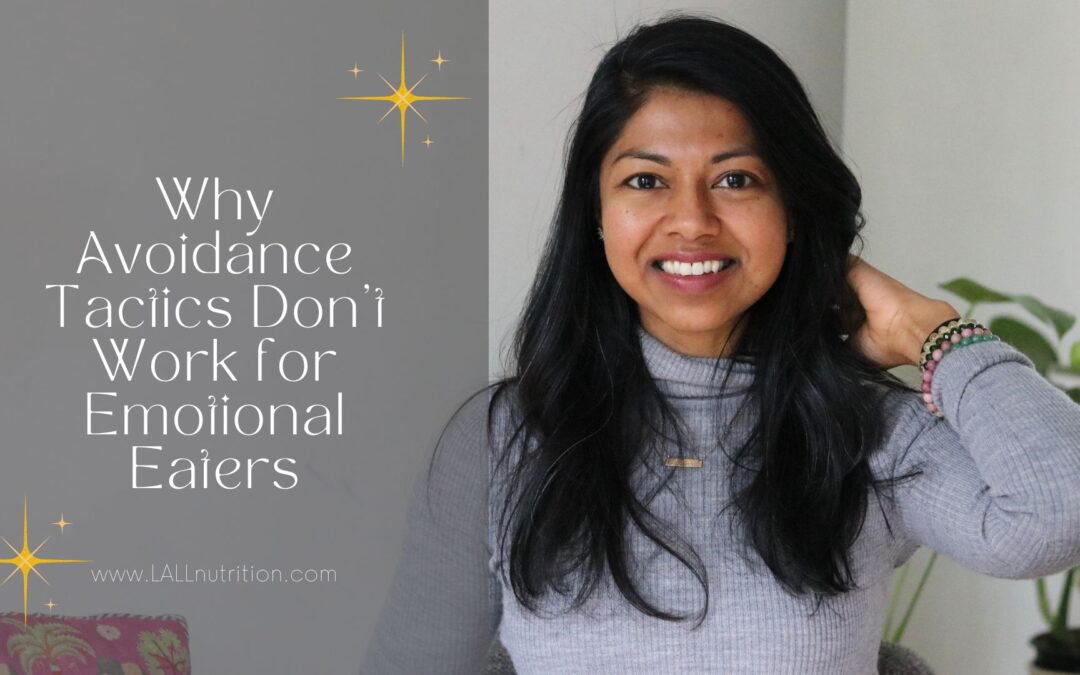Hello love,
Today I want to share with you why those tactics like avoiding your trigger foods or removing them from your house are not sustainable to resolve your emotional eating. I wanted to dive a bit deeper into this and share a case study with you.
Some of the advice we’re given when we emotionally eat is to avoid those trigger foods that make us emotionally eat. We’re using avoidance and that means that we are still out of control around food. We haven’t gotten to the deeper root of what’s been going on for us. Maybe freeze the “trigger” food, avoid the get together, or just avoid the food. That can temporarily work, but it also makes your life small.
Perhaps you can’t go out, you can’t be around certain foods, or you feel like you’re going to be taken over by the food.
This doesn’t give you choice or sovereignty.
This is something that a lot of my clients are looking for – having this choice where they make a decision to eat something and they’re not left with feeling shame or guilt or that they’re spiralling. This is possible when we get into the root of your emotional eating. When we resolve and dissolve this pattern, you can make those choices and you won’t feel you’re spiralling or you’re out of control. I hear this time and time again from clients.
Easeful Victory
Recently a client of mine who is halfway through The Emotional Eating Evolution Program was doing some Christmas baking and she had M&Ms in her home. Typically this would be one of her trigger foods and she would go towards it but she actually forgot that those M&Ms were around. She didn’t think about it. She had no need for it. They weren’t constantly on her mind and she wasn’t obsessing about it.
The reason is that we have been consistently doing the work and we are resolving her pattern. As she’s only halfway through the program we’ll see if more triggers come up and now she has the tools to resolve them.
She also has reignited her relationship to food and how it nourishes her body and she’s just feeling good overall.
I’m going to share with you what we have gone through in the program that makes it get to the root. A lot of the times in our society, whether we realize it or not, we are in some type of diet mentality. We have a set of rigid rules around food. You might not think you’re this way.
But these thoughts float around like:
My plate should be this small or this big.
I want to shrink my stomach.
I shouldn’t eat after six.
I ate too much. I’m going to stop drinking that much.
We have all of these different rules, and yes, it might be action steps we could take, but they’re not coming from an embodiment of who we are and understanding our body and understanding our patterns with food.
First Step
One of the first key steps when I work with clients and like this client who didn’t eat the M and Ms, is really creating that foundation of true nourishment. It is important to rebuild your relationship to food especially as an emotional eater. When you are an emotional eater, you can’t restrict and take things away because that’s your crutch. That’s what you use to soothe. By simply restricting you put yourself in a place where you’re going to derail yourself and create more bingeing.
Here we’re adding in things that we’re eating in a way that’s nourishing your body. We have morning rituals and creating meals that are satisfying hunger on all levels.
We’re nourishing your body so that you’re not restricting yourself, so that we reduce binges. It’s also a shift into opening yourself up to all foods. Not just, these are my diet foods and these are the foods I can only have. Really looking at your relationship to food. As we do that, we minimize some of the triggers around emotional eating.
We’re also looking at when are you truly hungry versus emotionally hungry. So as my client has been nourishing her body, some of those triggers have dissipated. She’s not thinking about the food, she’s realizing how good she feels. She’s looking forward to her morning smoothie or whatever it is that’s really grounding her and nourishing her.
It’s not because she has to have it, it feels good in her body.
Second Step
The second area that we’ve been working on is around body acceptance. This is an important area to know about the rhythms and rituals that are important to your body. So are you having the right movement for you or are you pushing yourself?
So this particular client she was overly working her body with a lot of intense exercise. Before she started the program she took a break.
She’s been connecting to the needs of her body and looking at what it actually means to accept your body as it is. We’ve begun to shift that “push” mindset and look at movement in a different way. Rituals around rest, and just understanding the body more and more and connecting to it. Even as we connect into hunger cues, or if we rest more, we’re connecting into our body and how our body feels and not pushing ourselves past that limit.
Because my client’s goal is to feel good in her body, to move towards health and so we need to shift her relationship to movement.
Third Step
The third area that’s important is emotional wellness. So all of these steps are happening at the same along with the emotional wellness piece. Here we were looking at the triggers and patterns around her emotional eating. We did a deeper dive with a 1:1 somatic meditation session, and she’s been doing the meditations in the program on her own working through the triggers and resolving them to move forward powerfully. Through these meditations, you find out what your true needs are and you’re able to give that to yourself. Then from there you know your next, genuine steps.
It’s not about putting a band aid on or using food to fill that hole. You notice we’re doing all these things at the same time.
Sometimes women come to me and they think they have their nourishment piece set in place, they have the perfect diet and it’s really about the emotions. But everything is tied in because if we are restricting around food, that’s going to trigger the obsession around food and we start bingeing, then we feel shame and then that triggers more emotional eating.
If we think we’re doing the right movement for our body but not connecting to our body, we might be mentally punishing ourselves, which triggers shame and emotional eating. Of course, if we’re doing the emotional work and not getting anywhere, we haven’t set up the structure around food + our body to know our next steps.
It’s all interconnected and done in a specific way to help you resolve your emotional eating pattern so that you can move forward powerfully. You start creating that feeling where you feel confident, at ease and good around food and in your body, step by step. This is so amazing.
All of these obsessions around food and your body dissolves because you’re empowered in who you are. When we are externalizing and we have the perfect diet or the perfect exercise plan or the perfect affirmations, we are not connected to who we are.
It might sound a little bit daunting, but with the right tools, it is not a daunting process. It’s more effortless and easeful. It takes some work, but it’s not as much effort that you’ve been putting into willpowering with the diets, exercise, etc.
That’s how we dissolve this. That’s how you can have foods around in your cupboard and ice cream and cookies and be at parties and choose the right things for your body because you’ll be so connected to who you are, you’ll know what feels good and you won’t have any guilt or shame if you do.
Invitation
So if what I’m saying to you is resonating for you and you desire this relationship to food and your body where it feels good, it feels at ease, is more sustainable and you’re not worrying and obsessing about food or reaching out for food every time you get hit with an emotion or stressful event then I’d love to invite you to check out more about The Emotional Eating Evolution Program HERE. This is my step by step methodology with lots of support and accountability and meditations.
To sovereignty with food,
Michelle
Certified Holistic Nutritionist + Emotional Eating Expert


